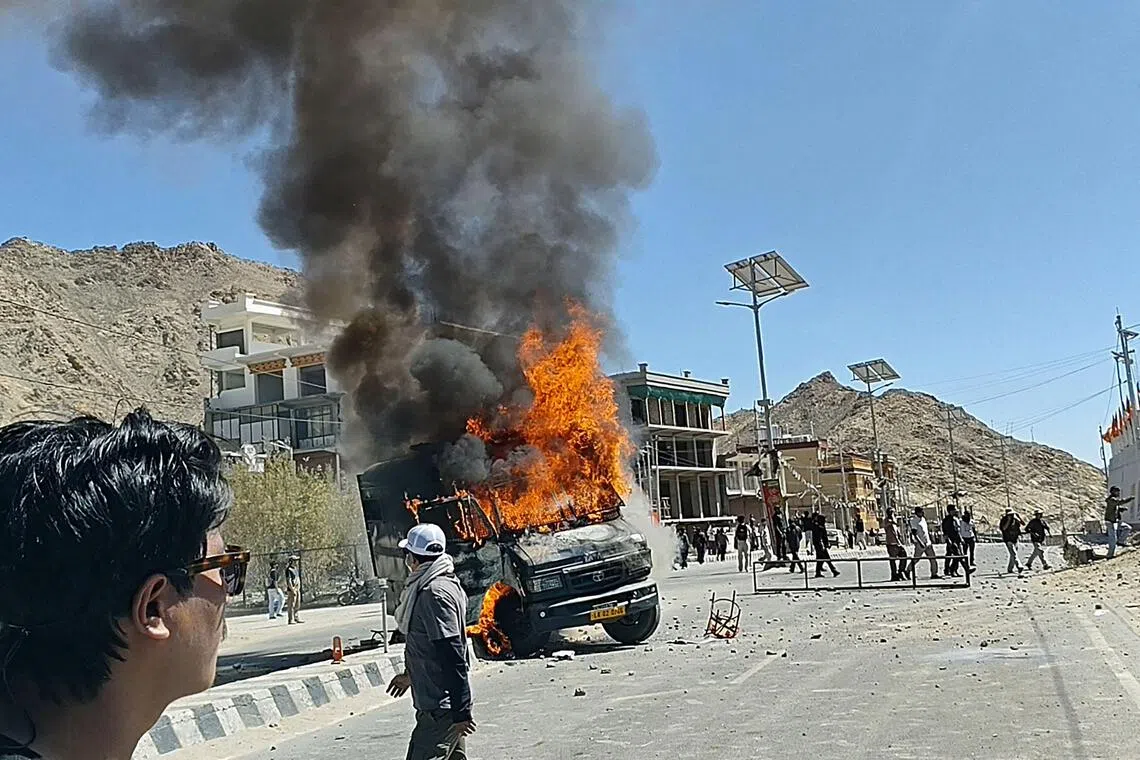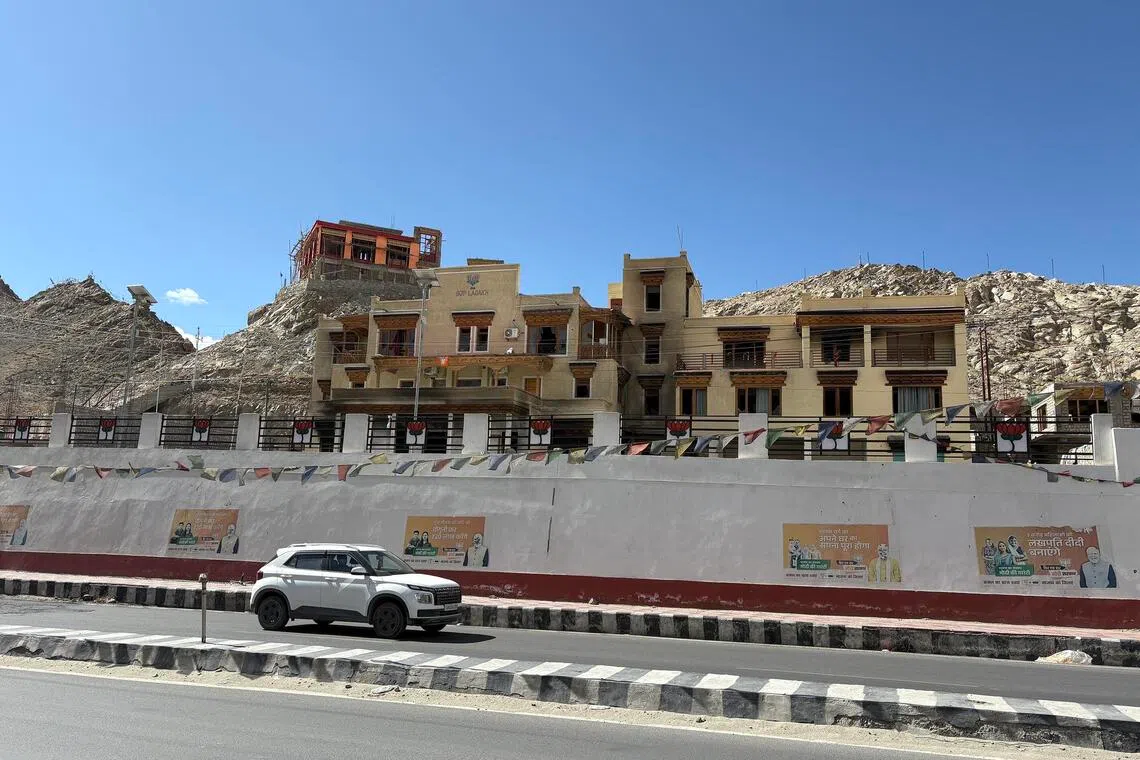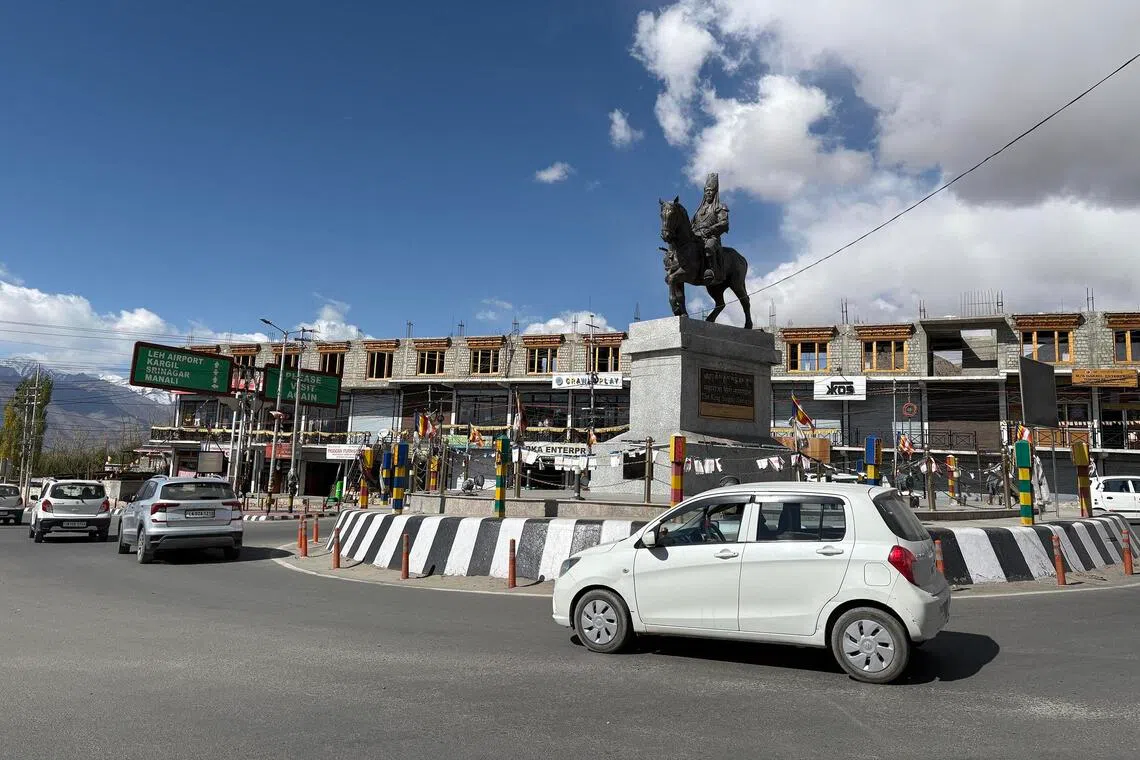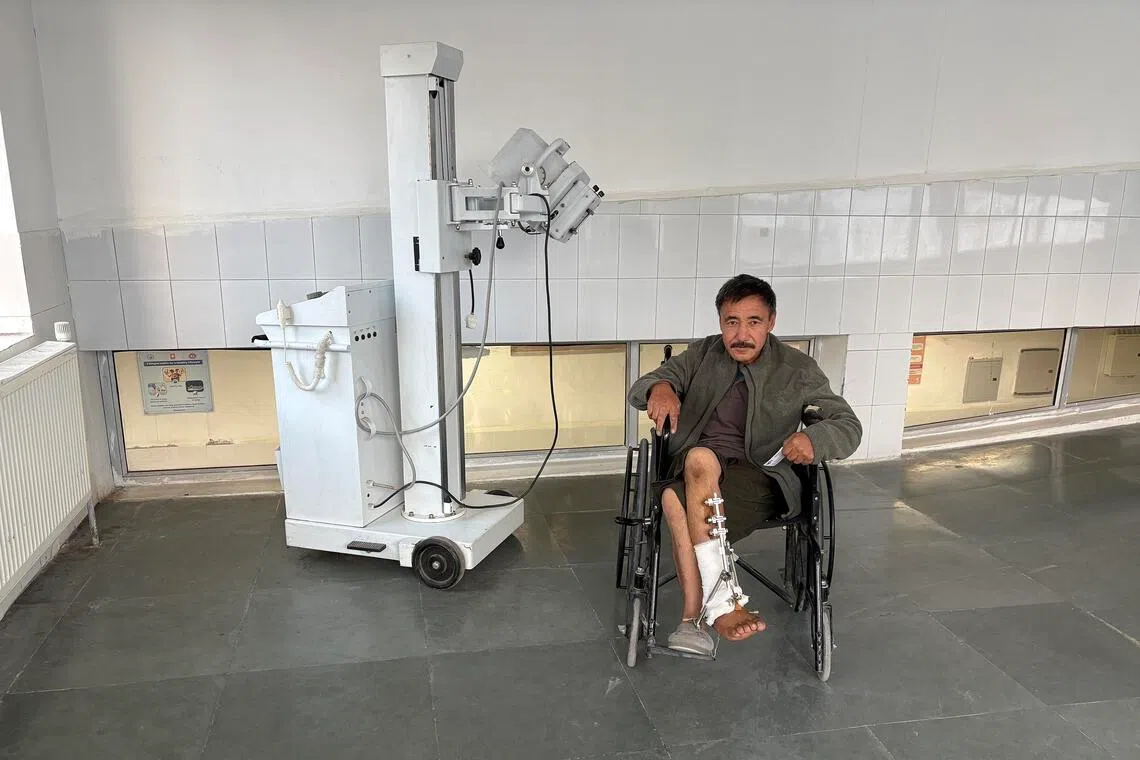In India’s strategic Ladakh region, demands for jobs and more autonomy risk boiling over
Sign up now: Get insights on Asia's fast-moving developments

Tensions exploded in Leh, the largest city of Ladakh, on Sept 24 when a peaceful protest for longstanding demands turned violent.
PHOTO: AFP
Follow topic:
- Ladakh faces internal tensions as demands rise for political representation, cultural safeguards, and jobs, erupting in violent protests on Sept 24, resulting in casualties.
- The roots of discontent stem from Ladakh's transition to a Union Territory in 2019, eroding local rights and leading to calls for statehood and Sixth Schedule inclusion.
- Despite government assurances and planned recruitment, local leaders warn of underlying unease and continue to push for Ladakhis' demands.
AI generated
LEH, India – In Leh, the largest city of Ladakh – a high-altitude border region bounded by Pakistan and China – the presence of the Indian military is unmissable, from shops selling military fatigues to army barracks and memorials to fallen soldiers.
A statue of Colonel Chewang Rinchen, a highly decorated Ladakhi officer who helped repel incursions into India from Pakistan in the 1940s, among other brave deeds, is just one among many memorials that stand as testament to the deep heritage of locals working with the Indian military to guard the country’s contested borders.
Unlike in other parts, where the presence of the military might cause unease among the local populace, the memorials and army shops here blend seamlessly into shops selling souvenirs with tourists and cafes serving steaming cups of coffee.
But trouble is brewing, and for a change not along the contested border areas of this 60,000 sq km region. Tensions are bubbling within as demands grow louder for greater political representation, demographic protection for the local tribes and cultural safeguards and jobs for its youth.
Those tensions exploded on Sept 24,
Four people, including a retired soldier, were killed as police opened fire, and more than 70 were injured in Leh, with dozens detained.
A charge of anti-nationalism, levelled by some sections of the media and commentators, further dispirited the close-knit community.
The crisis is more than just about a violent protest.
It throws up a key challenge for the government in a critical border frontier and heightens the urgency to address the demands of the people in Ladakh.
“It is very precious and sacred for us to save our own land, traditions and culture. But never in my wildest dream did I think something like this (violence) could happen, and four of our people would get killed,” said Ms Ladol, a local musician who took part in the protests and gave only one name.
“And then to call us anti-nationalists.”
Ladakh’s strategic importance
Ladakh’s borders are disputed by China to the east and by Pakistan to the north and west. Sandwiched between India’s two biggest rivals in the region, it is critical to India’s national security.
In 2020, Indian and Chinese troops clashed, leading to casualties
Still, the threat of a border flare-up remains undiminished, and Indian defence forces remain on a heightened state of alert.
On Ladakh’s northern border is the Siachen Glacier – the world’s highest battlefield between India and Pakistan – and in its west is Kargil, where the two countries fought a limited war in 1999.
Almost every family in Ladakh has helped the armed forces in some form – from joining the army to helping soldiers carry weapons and supplies as porters in high-altitude terrain. Locals living close to the border often provide intelligence, alerting the army to any incursions.
The support of the local populace is seen as critical to guarding the borders and aiding soldiers unused to high-altitude warfare.
“This narrative of Ladakhis being anti-nationalists needs to be nipped in the bud. It is absolutely incorrect, particularly for a population that has been solidly behind the nation,” said retired Lieutenant-General Deependra Singh Hooda, a former head of the army’s Northern Command.
He said that given the sensitivities along the border, the government needed to address local demands quickly.
“Where there are challenges along the border, you don’t want to be looking over your shoulder internally,” he told The Straits Times.
“So it is important for the government to take action and to look at what the demands of the people are and how much can be met. You don’t want this thing to simmer on in what is a strategically important area.”
Demand for greater representation
The roots of the current anger go back to 2019, when the Indian government revoked Article 370 of the Constitution
This move meant that Ladakh was no longer a part of the state of Jammu and Kashmir.
Initially, locals in Buddhist-majority Leh celebrated.
Many felt the region, with its unique culture and geography, had finally emerged from the shadows of Hindu-majority Jammu and Muslim-majority Kashmir.
But that excitement soon gave way to disillusionment as locals felt their rights were further eroded.
The new union territory was placed, with no legislature of its own, under the control of a lieutenant-governor appointed by New Delhi.
Mr Chering Dorjay Lakrook, president of the Ladakh Buddhist Association – a non-political socio-religious group, said: “We don’t have any legislative power now. We have our hill councils, which control only 10 per cent of the total budget of the union territory.”
When it was part of Jammu and Kashmir, Ladakh had representation in the state legislature. Now, its population of 274,289, according to the last population count in 2011, divided mainly between Muslim-majority Kargil and Leh, has one MP.
“The safeguards for land, culture and demography are important because 97 per cent of the population of Ladakh is tribal,” Mr Dorjay said.
At the heart of the local demands are statehood with an assembly and inclusion of Ladakh under the Sixth Schedule of the Indian Constitution – a provision granting special autonomy to tribal areas, allowing them to control land, forests and local customs through elected councils.
Such protections, Ladakh’s leaders argue, are essential not just for the tribal culture but also for preserving Ladakh’s fragile ecosystem by gaining approval from local stakeholders for large projects, such as large solar energy projects, amid climate change.
The youth protesters
The violence on Sept 24 erupted after two weeks of peaceful demonstrations, led by a hunger strike by Mr Sonam Wangchuk
Thousands turned up that day, and witnesses told The Straits Times that a section of the crowd, particularly a section of the youth, grew increasingly agitated and started throwing stones targeted at the police, who responded with tear gas and gunfire. The local office of the ruling Bharatiya Janata Party and a government building were set on fire in the chaos.

The local office of the Bharatiya Janata Party in Leh.
ST PHOTO: NIRMALA GANAPATHY
While locals saw the gunfire as excessive and blamed the police and Central Reserve Police Force for not acting speedily to stem the violence, the Ministry of Home Affairs said in a statement that the crowd had turned violent and that firing was “unavoidable”.
While the protests may be about political representation and cultural protection for older sections of the population, for the young they are also about their worries over unemployment.
The promise of jobs following the creation of the union territory has not materialised.
Tourism, the backbone of the local economy, continues to provide income; but government jobs – the only other source of employment – remain scarce, locals said.
According to official data, the rate of graduate unemployment increased to 26.5 per cent in 2022/2023, which was double India’s national average, from 9.8 per cent in the preceding period of 2021/2022.
“This violence has happened out of pure frustration and had been building up. The unemployment rate of graduates in Ladakh is the highest in the country. There are graduates and those with PhDs who came back after studying in other parts of India but aren’t able to find any job,” said Mr Tsering Stobgyal, a member of the youth wing of the Leh Apex Body (LAB), an apolitical, religious group.
Still, many locals bristle at comparisons between what is happening in Ladakh and the Gen Z protests in Nepal in September and more recently in Madagascar. They maintain that their demands are not just restricted to the youth.
But Mr Stobgyal noted: “Youngsters are very unhappy with the current situation.”
Balancing the external with the internal
The Ministry of Home Affairs said it remains open to dialogue with the groups spearheading the protests, including on the Sixth Schedule.
The statehood demand is aimed at providing political representation for Ladakh while the Sixth Schedule demand is aimed at providing an extra layer of autonomy for Ladakh by empowering local autonomous bodies to protect land and water resources, among other things.
In September, amid the peaceful protests, the federal authorities announced that recruitment for 1,800 government posts in Ladakh had begun, and earlier in the year recognised Bhoti and Purgi – languages spoken in Ladakh – as official languages.

When it was part of Jammu and Kashmir, Ladakh had representation in the state legislature. Now, its population of 274,289, divided mainly between Muslim-majority Kargil and Leh (above), has one MP.
ST PHOTO: NIRMALA GANAPATHY
Ladakh’s Lieutenant-Governor Kavinder Gupta said in an interview on Oct 3 with private Indian news agency Indo-Asian News Service that “those who didn’t want a peaceful Ladakh had instigated the youth”, and that the authorities must “identify and isolate” those responsible for the violence.
But civil society leaders insist that the protests were spontaneous and that the youth are being targeted, creating an atmosphere of fear.
Mr Asgar Ali Karbalai, leader of the Kargil Democratic Alliance (KDA) – a political and civil society coalition – warned at a press conference on Oct 14 that the government should “come out of the illusion” that normalcy had returned.
The KDA and LAB have announced plans for a silent peace march in Leh and a three-hour power blackout across Ladakh starting at 6pm local time on Oct 18.
“It is the lull before the storm,” Mr Karbalai said of the relative peace in the streets now, as demands continue for a judicial probe into the Sept 24 deaths.
Peaceful paradise remains on edge
Indeed, over two weeks after the unrest, life in Leh appears to have returned to normal.
Curfew restrictions have been lifted, and mobile internet – suspended after the clashes – has been restored.
A few tourists – Indians and foreigners – strolled through the bazaars as the tourist season tapered off.
“It’s so beautiful and so different from Vietnam,” said Ms Tran Hoai Thu, 30, who was visiting with a group of 17 people and sipping coffee in a local bakery. “The rivers, the mountains, the Himalayas... it feels spiritual. People are so kind and friendly.”
But that surface calm masks a deeper unease.
In the orthopaedic ward of SNM Hospital, 48-year-old Stanzin Otsal, a protester shot in the leg during the Sept 24 protest, lay recovering.

Mr Stanzin Otsal was shot in the leg during the Sept 24 protest.
ST PHOTO: NIRMALA GANAPATHY
A retired soldier from the Ladakh Scouts, the elite high-altitude regiment known as the “Snow Warriors”, Mr Otsal spent two decades serving, including near the India-Pakistan border.
“During my years in service, I took part in counter-terror operations, but never ate a bullet. But I got shot by the police during a peace protest,” he said with incredulity.
“But this”, he said, pointing to his leg, which was in a cast with pins sticking out and months of recovery ahead, “will not stop our demands to protect Ladakh”.
“Once I am able, I will rejoin the peaceful protests whenever they resume. We are just demanding our rights.”


